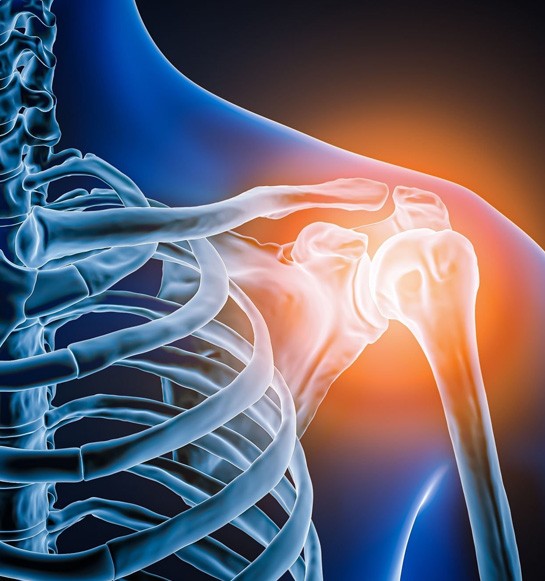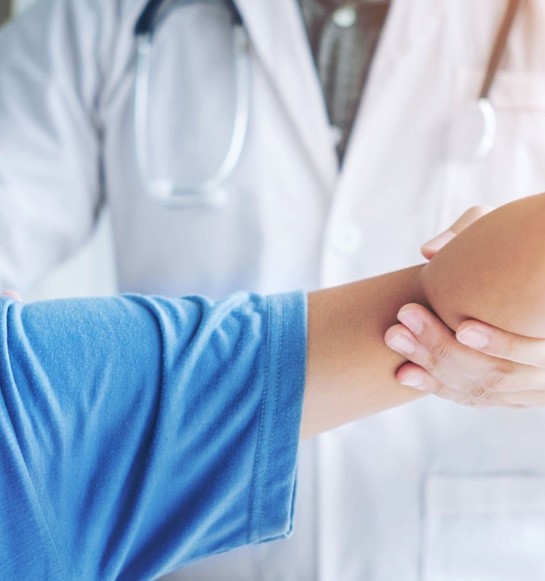
AC Joint Separation
Welcome to the Shoulder Homepage of Dr. Hans J. Poessel, a highly skilled and experienced German Orthopaedic Surgeon. Dr. Poessel specializes in the comprehensive management of shoulder conditions, including ac-joint separation pain, offering easy-to-understand and comprehensive care for patients seeking relief from this shoulder discomfort.
AC Joint Separation, Treatment and Surgery
The AC joint connects the collarbone (clavicle) to the shoulder blade (Scapula) and can be easily injured during a fall or high impact on same side. Pain and noticeable step-up deformity are two signs of damage to the AC joint.
AC Joint Separation Instability Treatment in UAE
The acromioclavicular (AC) joint connects the collar bone (clavicle) to the shoulder blade (acromion). There are multiple ligaments holding these bones together. The acromioclavicular (AC) ligaments stop the AC joint from moving side-to-side. The coraco-clavicular (CC) ligaments are between the clavicle and the scapula and stop the shoulder blade from dropping downwards. In an AC separation, one or both groups of ligaments may be injured. With even more trauma, the clavicle breaks through the muscle layer of the deltoid and trapezius muscles and can be seen under the skin. Typically, when the acromion bone is separated from the clavicle, the injury is often referred to as a shoulder “separation,” although in fact it is a dislocation. The term shoulder “dislocation” is most used to describe the separation of the humerus head (ball) from the glenoid (socket). The AC joint can get injured or “separated” in a fall or from a forceful motion to the shoulder, causing pain on top of the shoulder. There is often a bumpy deformity where the injury occurred where the clavicle becomes more prominent because the shoulder dropped downward. The pain usually subsides within a few weeks, but the deformity never goes away ever.
AC Joint Treatment FAQ
Are there alternatives to surgery?
– Yes, most cases are treated without surgery. Treatment may include wearing a sling, rest, physical therapy, activity modification, and use of ice packs to reduce swelling and pain. In high level athletes that may want to return quickly to their sport, injections into the AC joint can help alleviate swelling and pain, allowing the athlete to compete. However, this may expose the joint to more injury, and therefore this treatment is used very cautiously.
How often is major surgery necessary?
– For most patients with AC joint injuries, surgery is advised only if their symptoms do not improve to the level that they desire.
Any deformity or prominence of the clavicle, which is common after an AC joint separation alone, is not a good indication for surgery. Surgery is recommended for patients where the clavicle goes through the soft tissues of the deltoid and trapezius muscle and is present under the skin, or when the clavicle becomes trapped under the coracoid. The good news is that surgery performed three or more months after the injury is typically associated with the same level of success that can happen when the surgery is performed right away. By waiting to see if the shoulder improves without surgery, only a few patients will end up electing to have the surgical reconstruction. Fortunately, with advanced techniques -that include an internal brace with synthetic tape combined with a with tendon graft- the procedure is highly effective at restoring flexibility and range of motion to the joint and allowing an advanced strengthening program over time. In fact, an estimated 95% of patients can resume the same brisk tempo of physical activity they engaged in before the injury.
AC Joint Surgical Options
AC Joint Reconstruction
AC joint reconstruction after a full separation includes the use of a tendon and graft to reconstruct the ligaments that hold the scapula to the clavicle, and the acromion to the clavicle, supported by a powerful synthetic tape that help holds the repair together until the soft tissues have healed. Also, the connection between the deltoid and the trapezius is repaired, further strengthening the reconstruction.
Most of the procedure is performed arthroscopically through small incisions around the shoulder. In addition, the arthroscopy allows an inspection of the joint between the humerus and glenoid (gleno-humeral joint) where up to 15-20% of patients may have additional injuries.
After cleaning the areas where the ligaments attach between the clavicle and scapula (coracoid), a synthetic tape is passed through the clavicle and coracoid, then temporarily held together. This is followed by the passing of a tendon, usually a hamstring tendon allograft (from a cadaver), around the coracoid and around the clavicle. Once this is all completed arthroscopically, a small incision is made on the top of the shoulder to finalize the fixation with the synthetic tape, secure the tendon graft, and repair as well as possibly reconstruct the AC joint ligaments. The final step is repairing the strong tissue between the deltoid and the trapezius.
The entire weight of the arm is pulling downward on the reconstruction. Despite the strength of this surgical procedure, additional support to the arm and shoulder is necessary to help prevent the constant pull of gravity from disrupting the reconstruction. Therefore, it is essential that arm and shoulder are supported in a sling and pillow brace, or in some cases a firm gunslinger orthosis, whenever the patient is standing or sitting. Furthermore, the brace needs to be in place at night when sleeping. The brace is an important and necessary part of the successful surgical management of this condition.
The operation is typically performed as one day-case surgery on an outpatient basis. Again, more than 60% of the procedure is performed arthroscopically to minimize injury to the normal healthy tissues around this area.
Before you leave to recover at home, we will review your postoperative plan, including the need for wearing the brace, the first follow-up visit in 7-10 days, and the anticipation to start
supervised physical therapy approximately 6 weeks after the surgery.
Surgical Recovery of AC joint Reconstruction
You will go home the same day as your surgery to recover in the comfort of your home. You will need to wear a sling and pillow brace (Slingshot or Ultrasling) for six weeks after surgery. Sutures are taken out ca one week after surgery. Dr. Hans J. will give you specific instructions for post-op pain management.
After six weeks, you will begin a course of physical therapy to build flexibility in the shoulder at first, then gradually working towards a strengthening program. Every day you will need to move your shoulder, wrist, fingers and elbow to prevent stiffness and ensure the joint does not become locked into a narrow range of motion. By the third month, you will be able to engage in most normal daily activities, however it will take another 3 months or more to get your strength back for strenuous activities or recreational sports. If you are a bicyclist, which is a common association with this injury, you can get back on the road with your bike at 3 months, off on trails around 6 months. There is no surgery that can prevent this injury from happening again if you have an accident on your bike and land on your shoulder, so please be careful.
Surgical Results
The surgery has a high satisfaction rate. In addition to treating your pain, the procedure also has an aesthetic component: the surgery will eliminate most of the visible bump seen on top of the shoulder, although you may continue to see a small step-off between the collar bone and the shoulder blade. This is common even on shoulders that have not been injured because the end of the clavicle tends to widen and increase in size over our lifetime. Furthermore the muscle Power of the Shoulder Injury side is maintained as shortening due to fracture is reversed to normal.
For more information about AC joint separation and instability, please request an appointment with experienced German Orthopaedic shoulder surgeon Dr. Hans J. Poessel. Call or email our office today to schedule your visit.
Schedule Your Appointment Today!
If you are experiencing shoulder pain, stiffness, or limited mobility, don’t wait. Contact us today to schedule a consultation with Doc Hans, your orthopedic of choice and start your journey towards pain-free living.

